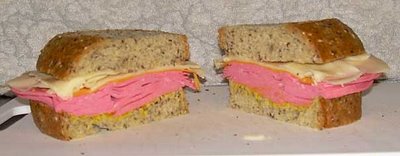A few years ago when the low carb fad was raging, my husband and I gave it a try. He still favors it but I gave up long ago. I just couldn't tolerate eating so much meat. The lesson I took away from it though was to minimize the consumption of certain types of carbohydrates and an overall increase in my knowledge of how blood sugar and insulin affect your body. I also learnd a bit about fatigue and how eating protein for breakfast can make you feel a lot better at work than having the usual toast and tea. Of course, I still have toast and tea but I know why I get tired 3 hours later.
Since my husband still favors going as low carb as possible, I developed a few recipes that I still use on a regular basis. One of them is low carb bread. This particular bread toasts very well and is quite soft and light. This is relatively unusual for low carb bread. There are variations on it that will increase or decrease the relative carbohydrate count but it is, all in all, a very healthy bread. The loaf has a rather nutty flavor because it contains a fair bit of flaxseed.
It is not, however, a normal bread. The texture isn't what you'd expect. The crust is relatively chewy and a bit tough. The interior is also "spongier" than regular bread but any increase in nutrition often comes with a "price". Additionally, you cannot use it for certain types of dishes because it tends to disintegrate more than regular bread when wet. Making French toast with it would be rather disappointing, for instance. That being said, it beats the hell out of any of the low carb bread mixes on the market and we've tried a lot of them. Those breads tend to be dense, heavy, and almost wet inside. They also will not toast at all.
Recipe for bread machine:
1/2 cup tepid water
1 egg
1 Tbsp. olive oil
1/2-1 Tbsp. honey
dash or two of salt
3/4 C. vital wheat gluten
1/3 cup soy or oat flour
1/3 cup ground flaxseed (finely or coarsely-ground depending on your tastes)
1 Tbsp. wheat bran (optional)
1 Tsp. yeast
Add the ingredients to the bread machine in the order given. If your bread machine has a yeast distribution pocket, place the yeast in the pocket. If it does not, make a well in the top of the dry ingredients and place the yeast in it. Set the crust color to "light" and bake on the "basic" setting (3 hours).
Those who live in Japan can get the specialized ingredients from Tengu Natural Foods or the Foreign Buyer's Club (FBC). I get the vital wheat gluten and flax from the FBC. I make my own oat flour by processing oatmeal in a food processor until it is finely ground. You can get soy flour at any Japanese grocery store. My husband doesn't care for soy flour which is why I substituted oats. However, soy will make for a lower carb bread and more protein.
The bread is so soft that it is hard to cut unless frozen. In fact, you can cut it very easily while frozen so I usually toss the loaf in the freezer overnight and cut off pieces from the frozen loaf as I need them for sandwich-making.

As an aside, I made my husband's lunch this morning with the bread pictured in this post. He bought this bologna that looks radioactively-pink. The color you see is not some sort of strange color shift from the camera. It's real. It is called "bologna salami" but tastes like regular bologna. I'm sure there's some weird chemical dye in it to make it that color but he wanted something different for lunch so we gave it a go. I know these look a little overstuffed with meat but they're actually quite small sandwiches. He is not a big eater and has only a half of a sandwich each day.


1 comment:
Wonderful!! I will give your recipe a try when I get back from my trip.
Post a Comment